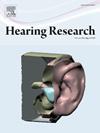Deep learning models for predicting hearing thresholds based on joint stimulus-frequency otoacoustic emissions and distortion-product otoacoustic emissions
IF 2.5
2区 医学
Q1 AUDIOLOGY & SPEECH-LANGUAGE PATHOLOGY
引用次数: 0
Abstract
According to the dual-source generation hypothesis, stimulus-frequency otoacoustic emissions (SFOAEs) and distortion-product OAEs (DPOAEs) arise from different cochlear mechanisms, and both are capable of characterizing hearing loss. However, their joint application for hearing threshold prediction remains unexplored. This study developed an efficient deep learning (DL) model integrating SFOAEs and DPOAEs to quantitatively predict hearing thresholds. Training data for the model were collected from 94 ears with normal hearing and 401 ears with sensorineural hearing loss. Frequency-specific DL models were constructed across five octave frequencies (0.5–8 kHz), with inputs including amplitude spectra and corresponding signal-to-noise ratio spectra of both SFOAEs and DPOAEs. Self-extractors of the model were constructed using convolutional neural network (CNN) and recurrent neural network (RNN), respectively. Cross-validation demonstrated that the dual-OAE model achieved mean absolute errors (MAEs) of 5.17, 3.83, 3.96, 4.71, and 4.90 dB at 0.5–8 kHz, significantly outperforming single-OAE DL models (except DPOAE-based models at 0.5 and 2 kHz) and baseline machine learning models. By reducing the number of OAE stimulus levels, the efficiency-optimized model reduced testing time per individual to approximately 15 min while preserving accuracy. The proposed dual-source OAE (SFOAE and DPOAE)-integrated DL model achieves state-of-the-art accuracy in hearing threshold prediction, with its optimized efficiency establishing a foundation for further developing a practical clinical tool for objective hearing loss diagnosis.
基于联合刺激-频率耳声发射和失真-积耳声发射预测听力阈值的深度学习模型
根据双源产生假说,刺激频率耳声发射(sfoae)和失真产物耳声发射(dpoae)由不同的耳蜗机制产生,两者都能够表征听力损失。然而,它们在听力阈值预测中的联合应用尚未探索。本研究建立了一种高效的深度学习(DL)模型,将sfoae和dpoae集成在一起,定量预测听力阈值。模型的训练数据来自94只听力正常的耳朵和401只感觉神经性听力损失的耳朵。在5个倍频频率(0.5-8 kHz)上构建特定频率的DL模型,输入包括sfoae和dpoae的幅度谱和相应的信噪比谱。分别使用卷积神经网络(CNN)和递归神经网络(RNN)构建模型的自提取器。交叉验证表明,双oae模型在0.5 - 8 kHz时的平均绝对误差(MAEs)分别为5.17、3.83、3.96、4.71和4.90 dB,显著优于单oae DL模型(0.5和2 kHz时基于dpoae的模型除外)和基线机器学习模型。通过减少OAE刺激水平的数量,效率优化模型将每个个体的测试时间减少到大约15分钟,同时保持准确性。本文提出的双源OAE (SFOAE和DPOAE)集成DL模型在听力阈值预测方面达到了最先进的精度,其优化的效率为进一步开发客观听力损失诊断的实用临床工具奠定了基础。
本文章由计算机程序翻译,如有差异,请以英文原文为准。
求助全文
约1分钟内获得全文
求助全文
来源期刊

Hearing Research
医学-耳鼻喉科学
CiteScore
5.30
自引率
14.30%
发文量
163
审稿时长
75 days
期刊介绍:
The aim of the journal is to provide a forum for papers concerned with basic peripheral and central auditory mechanisms. Emphasis is on experimental and clinical studies, but theoretical and methodological papers will also be considered. The journal publishes original research papers, review and mini- review articles, rapid communications, method/protocol and perspective articles.
Papers submitted should deal with auditory anatomy, physiology, psychophysics, imaging, modeling and behavioural studies in animals and humans, as well as hearing aids and cochlear implants. Papers dealing with the vestibular system are also considered for publication. Papers on comparative aspects of hearing and on effects of drugs and environmental contaminants on hearing function will also be considered. Clinical papers will be accepted when they contribute to the understanding of normal and pathological hearing functions.
 求助内容:
求助内容: 应助结果提醒方式:
应助结果提醒方式:


